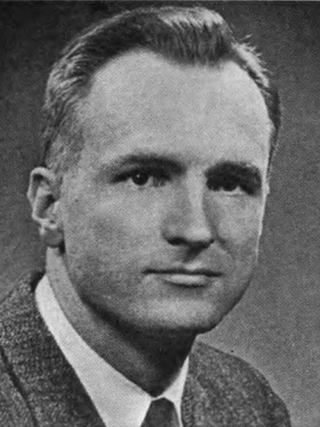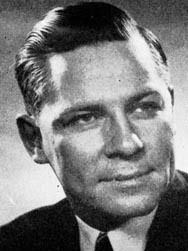
Hook's Drug Stores was an Indianapolis, Indiana-based drug store chain which was founded in 1900 by John A. Hook. The chain flourished throughout central Indiana for most of the 20th-century.
John J. Barton was an American politician who served one term as mayor of Indianapolis. During his time in office, plans were made for the construction of the Indiana Convention Center. He was defeated for re-election by Indianapolis Board of School Commissioners member and future United States Senator Richard Lugar in 1967.
Thomas Building was a high rise building in Indianapolis, Indiana. It was completed in 1895 and had 13 floors. It was primarily used for office space. It was heavily damaged in the W. T. Grant fire on November 5, 1973 and subsequently demolished.
Henry Franklin West was the fifth mayor of the city of Indianapolis, Indiana. West, a Democrat, took office in 1856 but died within the first month of his term.
William John Wallace (1814–1894) was an Irish-American politician. He was the seventh mayor of the city of Indianapolis, Indiana, and the first Republican to hold that office.
Daniel Webster Grubbs was an American lawyer, businessman and politician who served as the 13th mayor of the city of Indianapolis, Indiana. Born in Henry County, Indiana, Grubbs moved to Indianapolis in 1857 to study law. His political career began in 1878 when he was elected alderman. Grubbs, a Republican, resigned in 1881 during his successful campaign for mayor. He served a single term (1881–1884) and did not seek re-election. Instead, he returned to his business career and moved to Parral, Mexico, where he managed the mining and banking interests of his wife's family.
Charles G. Coulon was the sixth mayor of the city of Indianapolis, Indiana. Coulon emigrated from Germany in 1847 to avoid military service. Coulon arrived in Indianapolis in 1852 where he studied law and eventually opened an office. He was elected as justice of the peace in 1856. In November of that year, then mayor Henry F. West died and Coulon was appointed as interim mayor by the city council. He held office for two weeks and was replaced by William J. Wallace who won the extraordinary election. Coulon finished his first term as justice of peace (1864-1860), a post he also held from 1864 to 1868.
Charles Webster Jewett was an Indiana lawyer and Republican politician. Jewett, who studied law at Harvard University, was chosen as chairman of the Marion County Republican Committee in 1914. He was the mayor of Indianapolis from 1918 to 1921. In the 1917 Republican primary election for the mayoral candidacy, Jewett had defeated Samuel L. Shank who eventually succeeded him as mayor. In 1938, Jewett ran for a seat in the United States House of Representatives and lost to the incumbent Louis Ludlow.

The Minton–Capehart Federal Building is a United States federal building in Indianapolis, Indiana, that is named in honor of former U.S. Senator and U.S. Supreme Court Justice Sherman Minton and former U.S. Senator Homer E. Capehart.

The Indianapolis mayoral election of 1967 took place on November 7, 1967. Richard Lugar defeated incumbent Democratic mayor John J. Barton, becoming the first Republican to be elected mayor of Indianapolis in nearly two-decades. Democrats had long dominated mayoral elections before 1967, having won ten of the thirteen mayoral elections since 1930. No Democrat would subsequently recapture the mayoralty until 1999, largely due to the city-county merger that created the Unigov in 1970 adding the votes of suburban Marion County, which shifted the composition the electorate towards the Republicans.

The Indianapolis mayoral election of 1971 took place on November 2, 1971. This was the first election after the creation of the Unigov. Incumbent Republican Richard Lugar was reelected to a second term. Lugar's challenger had been Democrat John Neff, a former state senator. Neff had campaigned in opposition to the Unigov, promising to seek its abolishment if elected.

The Indianapolis mayoral election of 1975 took place on November 4, 1975 and saw the election of Republican William H. Hudnut III.

The Indianapolis mayoral election of 1991 took place on November 5, 1991 and saw the election of Republican Stephen Goldsmith.

The Indianapolis mayoral election of 1979 took place on November 6, 1979 and saw the reelection of Republican William H. Hudnut III.

The Indianapolis mayoral election of 1983 took place on November 8, 1983, and saw the reelection of Republican William H. Hudnut III to a third term.

The Indianapolis mayoral election of 1987 took place on November 3, 1987, and saw the reelection of Republican William H. Hudnut III to a fourth term.
The Indianapolis mayoral election of 1959 took place on November 3, 1959 and saw the reelection of Charles H. Boswell, who had become mayor eleven months earlier, after Philip L. Bayt resigned to become Marion County Prosecutor. Boswell defeated Republican William T. Sharp.
The Indianapolis mayoral election of 1955 took place on November 8, 1955 and saw the election of Philip L. Bayt to a second non-consecutive term. Bayt's opponent was Republican James O. Birr.

The Indianapolis mayoral election of 1951 took place on November 6, 1951 and saw the election of Republican municipal court judge Alex M. Clark as mayor, defeating Democratic incumbent Philip L. Bayt. Clark became one of the youngest mayors in Indianapolis' history.
The 1925 Indianapolis mayoral election was held on November 3, 1925 and saw the election of Republican former Marion County treasurer John L. Duvall, who defeated Democratic former Indianapolis city attorney Walter Meyers.






